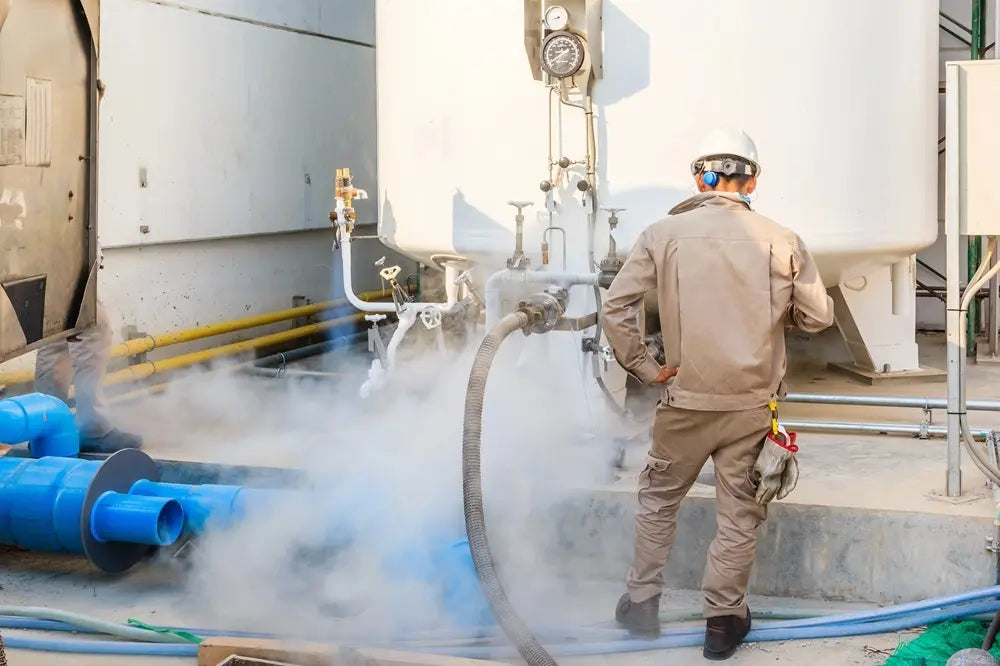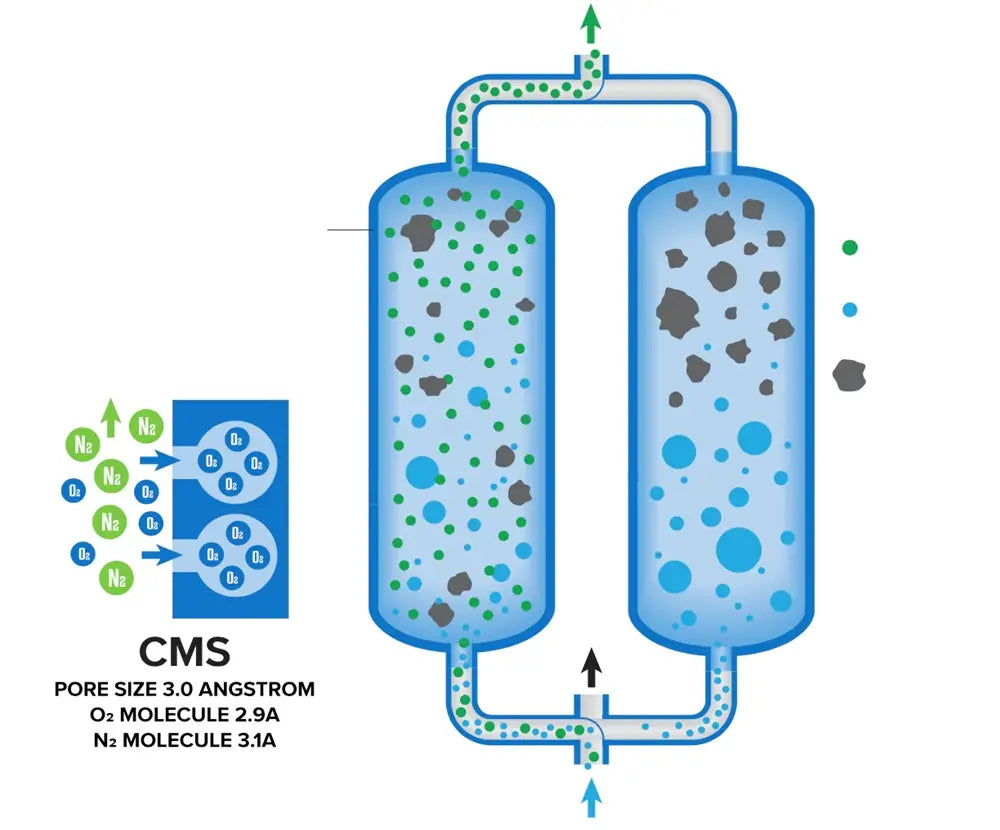Nitrogen generators create purified nitrogen gas out of thin air. How do they do it? Let’s take a closer look at the science of nitrogen generation.
If you use a lot of nitrogen gas (N2) in your processes, nitrogen generation may be a good option for you. Onsite nitrogen generation is increasingly popular for companies that regularly consume nitrogen. A nitrogen generator ensures a continual supply of N2 at the purity that you need, when and where you need it. Over time, generating your own nitrogen gas on demand is much more convenient and cost-effective than purchasing bulk gas from a contract supplier. The more gas you use, the faster your N2 generator will pay for itself. Here’s how common nitrogen generation technologies work.
What Is a Nitrogen Gas Generator?
A nitrogen gas generator makes N2 on demand by separating nitrogen from the other gasses in the air we breathe. Nitrogen is the most abundant element in Earth’s atmosphere, making up about 78% of our air by mass.

- Nitrogen: 78%
- Oxygen: 21%
- Argon: 0.93%
- Carbon dioxide: 0.04%
- Trace gasses: 0.03% (includes Neon, Helium, Methane, Krypton, Hydrogen & Water Vapor)
Nitrogen generators use chemical or physical processes to separate the nitrogen from the other gasses. Once the N2 is separated from the other gasses, it can be stored in a pressure vessel for use in various industrial applications.
With onsite nitrogen generation, you have a limitless supply of nitrogen gas for your needs. Because nitrogen is so abundant in the atmosphere, you will never run out of N2 in the ambient air.
Types of Nitrogen Generators
There are several technologies available for nitrogen generation. The three most commonly used nitrogen separation technologies are cryogenic separation, membrane separation and adsorption. Of these, adsorption is the most commonly used method for onsite nitrogen generation.
Cryogenic Nitrogen Separation
Cryogenic nitrogen plants use thermal separation to purify gasses from the air. Atmospheric air is pressurized and cooled to very low temperatures. Different molecules have different boiling points, meaning they will turn from gas to liquid at different temperatures. The cryogenic plant uses these physical properties to distill liquid nitrogen out of the air.

Cryogenic separation can produce large volumes of nitrogen at very high purities, but it is very energy intensive. This method is only used by large plants producing massive volumes of liquid nitrogen. Liquid nitrogen (bottled or bulk delivery) usually comes from a cryogenic plant.
Membrane Nitrogen Separation
Membrane gas separation technologies use the principle of diffusion to separate gasses. A membrane gas separator has two chambers separated by a membrane and held at different pressures. The difference in pressure between the chambers drives the gas molecules through the membrane. Different gasses will diffuse through a membrane at different rates due to the size of their molecules. This differential velocity allows the system to separate out the nitrogen from other gasses.
Membrane nitrogen generators are valued for their simplicity, reliability, cost efficiency and the ability to produce nitrogen on-demand without the need for cryogenic distillation or energy-consuming adsorption processes. They are widely used in applications where ultra-high purity nitrogen is not needed, such as in tire inflation, fire suppression, pipeline purging and certain chemical processes. Their simple design, with few or no moving parts, makes them low-maintenance and ideal for remote or rugged applications such as oil & gas pipelines or military bases. They are also cheaper, so they may be an option for facilities that require smaller amounts of semi-pure nitrogen and do not want to invest much capital up front. However, they have limited capacity and relatively low purity (95% - 99%) compared to adsorptive technologies. For these reasons, adsorption is generally preferred for applications requiring high flow rates and high purity.
Adsorption Nitrogen Generators
Adsorption technologies work by fixing gasses with a solid substance. Adsorption is a process in which molecules of a liquid or gas are bound by physical or chemical means to the surface of a solid. Adsorptive materials such as activated carbon are composed of small beads with many tiny micropores inside to maximize the available surfaces that molecules can adsorb to. Leveraging the selective adsorption characteristics of specific materials, PSA systems can achieve nitrogen purity levels up to 99.999%, making them ideal for applications that require very high purity, such as electronics manufacturing, pharmaceuticals, and laboratory research.
PSA nitrogen generators are highly reliable and energy efficient. An onsite PSA generator can save companies up to 50% or more compared to the cost of purchasing bottled N2 gas (based on operating expenses). These systems offer a scalable solution that can be tailored to match specific flow rates and purity requirements, providing a reliable and self-sufficient nitrogen supply. Their widespread application across various industries underscores their effectiveness in meeting stringent nitrogen purity standards while offering operational flexibility and cost savings.
How a Membrane Nitrogen Generator Works

A membrane nitrogen generator works by separating nitrogen from other gasses in the air using a selective permeation process through a specially designed membrane. The air we breathe is approximately 78% nitrogen and 21% oxygen, with the remainder being argon, carbon dioxide, and trace gasses. The principle of membrane nitrogen generation leverages the differences in the rates at which these gasses permeate through the membrane material.
Here's a step-by-step explanation of how the process works:
- First, atmospheric air is compressed to a higher pressure using an air compressor. This compressed air is then treated to remove water vapor, oil and particulates.
- The cleaned, compressed air is then directed into the membrane module. This module contains thousands of hollow fibers or bundles made from a special polymer material designed for gas separation. The interior surfaces of these fibers are selective to various gasses based on their size and the ability to dissolve into the membrane material.
- As the compressed air flows through the hollow fibers, oxygen, water vapor and other gasses permeate the membrane walls much faster than nitrogen due to their smaller molecular size or higher solubility in the membrane material. As a result, nitrogen is enriched within the hollow fiber membranes and collects in the center of the fibers.
- The purity of the nitrogen produced can be adjusted by controlling the flow rate of the compressed air through the membrane module and the operating pressure.
- The nitrogen gas that exits the membrane module is collected and can be stored in a tank or piped directly to where it is needed. Oxygen, water vapor and other removed gasses are vented back to the atmosphere.
How a PSA Nitrogen Generator Works
Pressure Swing Adsorption (PSA) is the most commonly used nitrogen generation technology for onsite gas generation. PSA nitrogen generators work using the basic principles of adsorption. The name comes from the way they use pressure swings to increase adsorption during the separation phase and then recharge the adsorbent material. A dual-chamber PSA enables continual nitrogen generation, with one chamber producing N2 while the other chamber recharges.
- The chambers are filled with an adsorbent material called a Carbon Molecular Sieve (CMS). Each CMS bead has thousands of microscopic pores. Small gas molecules such as oxygen (O2) adsorb to the surfaces at a higher rate than the larger N2 molecules.

- The rate of adsorption increases when the chamber is pressurized. Purified nitrogen gas is separated out of the chamber and stored when it reaches the desired level of purity.
- When the chamber is depressurized, excess oxygen and other gasses trapped within the CMS pores are released, recharging the beads for the next cycle of pressurization and adsorption. Excess oxygen and other gasses are released back to the atmosphere before the cycle begins again.
- Each chamber swings between a high-pressure nitrogen generation phase and a low-pressure regeneration phase, enabling continuous production of nitrogen gas.
Ready to Get Started with Onsite Nitrogen Generation?
Check out our Compete Nitrogen Generation Buyer’s Guide for more information. Contact Fluid-Aire Dynamics to see how much you could save by producing your own nitrogen.
©2024 Fluid-Aire Dynamics, Inc. All Rights Reserved.
